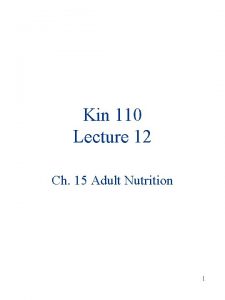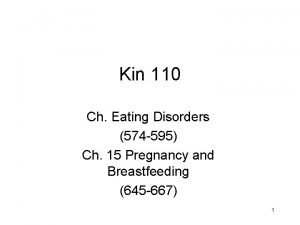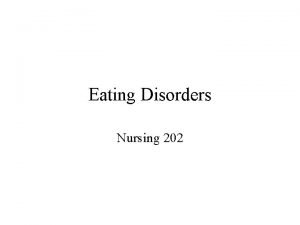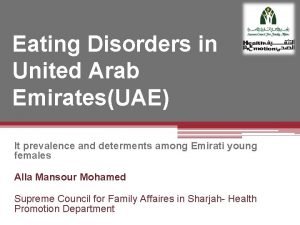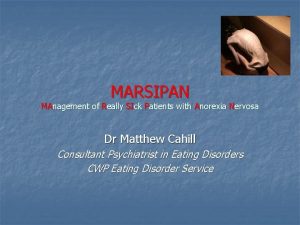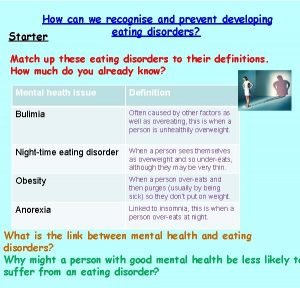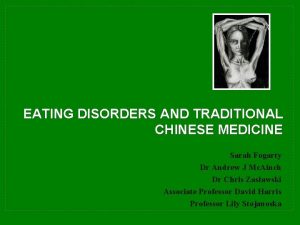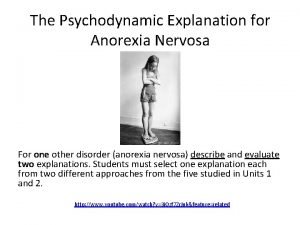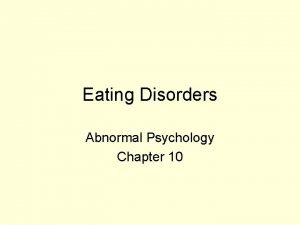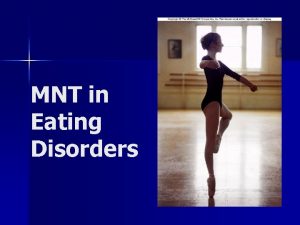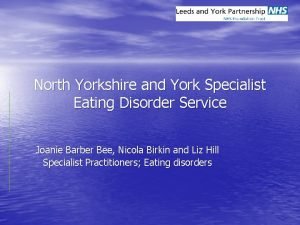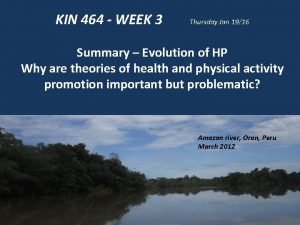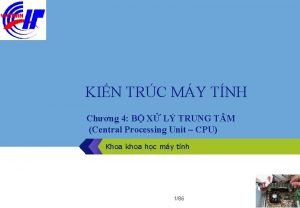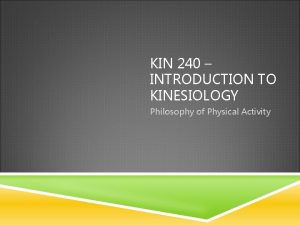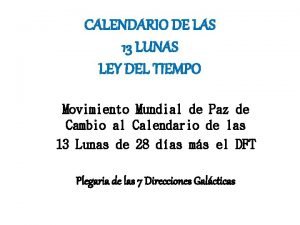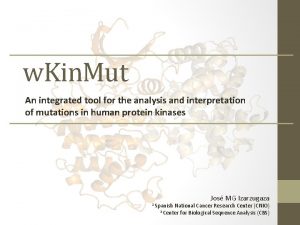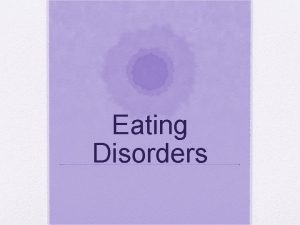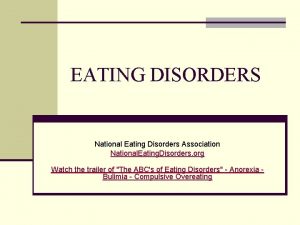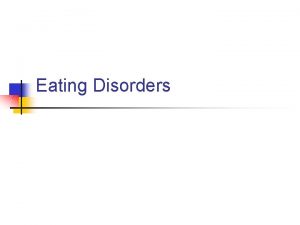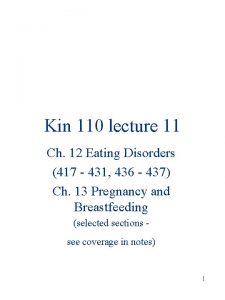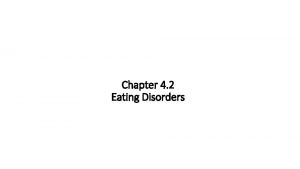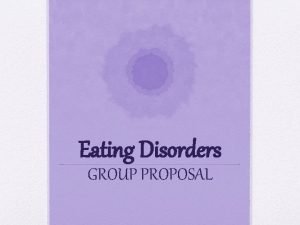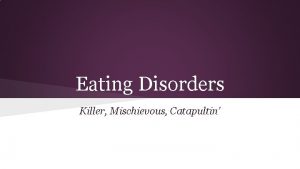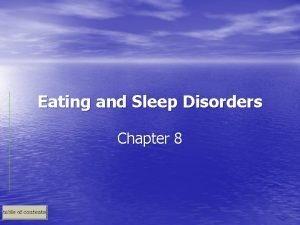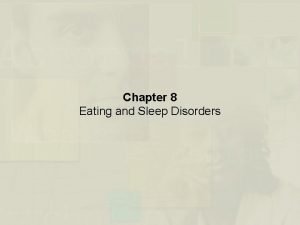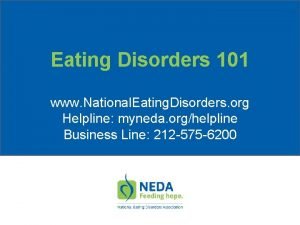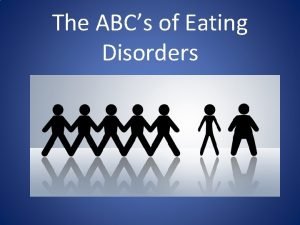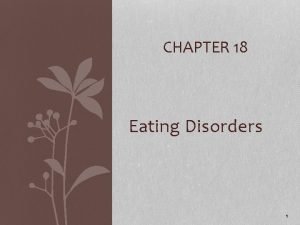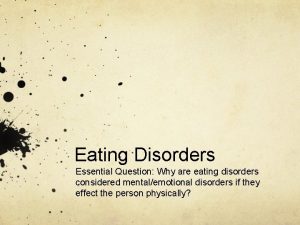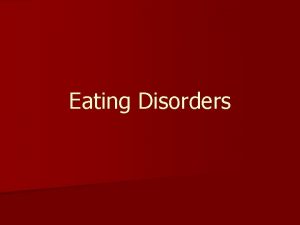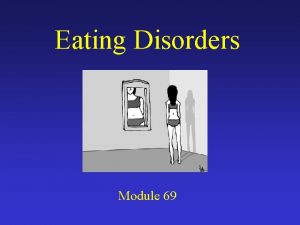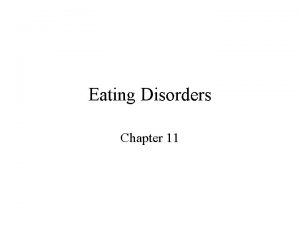Kin 110 lecture 11 Ch 11 Eating Disorders



























- Slides: 27

Kin 110 lecture 11 Ch. 11 Eating Disorders (p. 385 -403) Ch. 12 Pregnancy and Breatsfeeding (p. 414 -417; 419 -424; 434 -437) 1

Eating Disorders • Eating serves psychological, social and cultural purposes • Media bombards us with ‘ideal’ body types • may develop unhealthy relationship with eating, obsessive weight loss and strange rituals around food • Food often linked with personal and emotional experiences 2

Eating Disorders – Psychological disorders; erode medical, social and psychological well being • Anorexia Nervosa – psychological loss or denial of appetite and self starvation, related in part to distorted body image and various social pressures associated with puberty – extreme weight loss, irrational fear of obesity and weight gain – Tables 11 -1 3

Anorexia Nervosa • Profile - competitive, obsessive, parents set extremely high standards • hypergymnasia - excessive exercise • early warning signs - rituals with food • cook large melas for others, not self • Physical signs and symptoms fig 11 -4 • Treatment - intervention by family and friends • team of physicians, dieticians, psychologists – nutritional therapy – psychological therapy 4

Bulimia Nervosa • college age young adults • large quantities of food are eaten at one time (binge) and then purged from the body by vomiting, laxatives or other means • Tables 11 -1 • difficult to recognize, outer appearance is normal, self reported • obsessive cycle of bulimia (fig 11 -6) • health problems fig 11 -4 • Treatment - team of physicians – reduce binges, address misconceptions about food 5

Other Eating Disorders • Baryophobia - disorder of young children - stunted growth – parents underfeed to prevent obesity • Female Athlete Triad • high percentage of female athletes exhibit disordered eating patterns • coupled with irregular menstruation – ammenorhea • loss of bone mass - osteoporosis • treatment – – decrease preoccupation with food increase meals rebuild body establish regular menstruation 6

Binge Disorder • Compulsive overeating – binge episodes without purging at least twice per week • may not deal with emotional problems effectively • never learned appropriate ways to deal with feelings • Should learn to eat in response to hunger • avoid sliming diets initially • generally require professional help. 7

Preventing eating Disorders • Some concern about diet, health and weight is normal • some fluctuation in weight and appetite is normal – *large changes consult physician • Discourage restrictive diets, meal skipping and fasting • provide information about the normal changes with puberty • correct misconceptions about – nutrition, body weight, weight loss 8

Preventing Disorders • Carefully phrase weight related comments/recommendations • encourage normal expression of disruptive emotions • encourage children to eat when they are hungry • provide adolescents with some choices and self-accountability 9

Pregnancy Overview • Special considerations for time of life • illustrates larger importance of nutrition on body functioning • Important to plan pregnancy – modification of lifestyle – adequate nutrition – prevent fetal and infant problems • + 300 kcal per day – milk, meats and alt. – Iron, calcium, and folate (400 ug/day) • breastfeeding 10

Prenatal Growth • Ovum to fetus first 8 weeks • fetus to infant 32 weeks • nourished until birth by placenta – organ formed in mothers uterus – oxygen and nutrient exchange – fetal waste removal – release of hormones of pregnancy 11

Early Growth • Hyperplasia – increase in cell number • Hypertrophy – increase in cell size • 3 weeks – specialized organs and body parts begin to form – * many women still do not know they are pregnant* • 13 weeks – heart is functional, most organs formed, fetus can move 12

First Trimester • 9 months broken into three sections, trimesters • first trimester is critical time – spontaneous abortion, ~1/3 – genetic defects or fatal error in fetal development • very important to avoid harmful substances and maintain adequate nutrition – nutritional deficiencies transferred through placenta 13

Second Trimester • Fetus weighs ~ one ounce • limbs fully formed, has ears and begins to form tooth sockets • fetal heart beat can be detected with stethoscope • begins to look like infant, formed bones, can kick, suck its thumb • mothers breast weight inc. 30% • under nutrition can impair ability to breast feed 14

Third Trimester • Weighs 2 -3 lbs. • Fetus will deplete iron stores and blood glucose • infants born after 26 weeks have a good chance of survival in nursery – difficulties suckling and swallowing • 9 months – 7 -9 lbs. (3 -4 kg) 50 cm long – soft spot where skull bones will fuse (12 -18 months) 15

Nutrient Needs • emphasis is on increased nutritional requirements – individual requirements • Energy Needs • + 300 kcal / day – in 2 nd and 3 rd trimesters ( 2 cups low fat milk and piece of bread) • nutrient dense foods, increased nutrient requirements vs kcal • vitamin and mineral needs increase 20 -100%; kcal 15 % 16

Weight Gain • If active, add extra kcal for exercise to total intake – Walking, cycling, swimming recommended activities – specific precautions p 419 • Weight gain one of best predictors of pregnancy outcome – – 2 - 4 lbs. in first trimester. 75 - 1 LB per week, 2 nd and 3 rd total gain 25 -35 lbs. (BMI ~20 -26) fig 12 -5 p 421 • Requires regular monitoring • weekly record, allows for adjustments 17

Specific Nutrients • RDA for protein • Increase 10 - 15 g – many already over this – important to check, – role of protein? • Carbohydrates – 100 g / day to prevent ketosis(avg 200) • • vitamins most increase slightly Folate (RDA 600 ug) synthesis of DNA, rbc formation • folate rich fruits and veg, fortified cereals 18

Mineral Needs • IRON • 2 times the RDA in last two trimesters (30 mg/day) • hemoglobin synthesis – *fortified breakfast cereals* • attention to nausea and absorption (caffeine) • severe iron deficiency, LBW, and risk of fetal death 19

Mineral Needs • Calcium – adequate mineralization of fetal skeleton and teeth in 3 rd tri – increase intake with conception – 1200 - 1500 mg (milk group) • Zinc – growth and development – Increase 25 % above RDA 20

Vegetarian Mothers • Lacto ova or lacto should have no special concerns, with earlier recommendations in mind • iron • Vegans • focus on protein, vitamins D, B -6, B-12, iron and calcium • increase grains, beans nuts and seeds • Avoid Ketosis - difficult for fetal brain to utilize 21

Nutrition of Milk • Asses adequate intake by monitoring wetness and stool production • supplements with formula may be needed and are OK • should not start before breastfeeding is well established • important differences from cows milk (wait 1 year) – casien - protein difficult to digest – different minerals and carbos 22

Nutrition of Milk • Colostrum – first product of breast • antibodies – compensate for immature immune system – promotes intestinal health of infant • Mature Milk – after a few days, very different from cows milk 23

Mature Milk • Main proteins from a soft light curd in GI • binds iron and reduces bacterial growth • high in essential fatty acids and fats needed for brain development • DHA, visual acuity and nervous system development 24

Mature Milk • Composition changes • increased fat content with feeding, should last 20 min. to get good growth and infant satisfaction • can supplement up to 4 ounces of water / day 25

Food Plan and Breastfeeding • Only slightly different from pregnancy • no longer require iron, folate • increased need for energy, vit. A and C, niacin and zinc • * increase milk group intake* • should maintain balanced diet, moderate fat content, maintain fluid intake • avoid crash diets 26

Milk Production • Requires ~ 800 kcal /day • recommend increase only 500 kcal per day • facilitates return to prepregnancy weight • *breast feeding enhances reduction of uterus • * may prevent breast cancer if maintained for several months • Table 12 -2 27
 Kin 110
Kin 110 Kin 110
Kin 110 Où se trouve le numéro d'affiliation mutuelle vignette ?
Où se trouve le numéro d'affiliation mutuelle vignette ? 000 111 000
000 111 000 Hypothalamus eating disorders
Hypothalamus eating disorders Eating disorders in uae
Eating disorders in uae Isabelle caro before photos
Isabelle caro before photos How to spot eating disorders
How to spot eating disorders Acupuncture for eating disorders
Acupuncture for eating disorders Anorexia psychodynamic explanation
Anorexia psychodynamic explanation An eating disorder in which people overeat compulsively
An eating disorder in which people overeat compulsively Kate moss eating disorder
Kate moss eating disorder Chimpanzee eating termites
Chimpanzee eating termites Mnt for eating disorders
Mnt for eating disorders York eating disorder unit
York eating disorder unit Chapter 18 eating and feeding disorders
Chapter 18 eating and feeding disorders 01:640:244 lecture notes - lecture 15: plat, idah, farad
01:640:244 lecture notes - lecture 15: plat, idah, farad Pinna acoustics
Pinna acoustics Chấn thương ngực kín slide
Chấn thương ngực kín slide D kin
D kin Kin 464
Kin 464 Logo tnh
Logo tnh Kin240
Kin240 Sincronario 13 lunas
Sincronario 13 lunas Kin games
Kin games Svm kernel
Svm kernel William hamilton kin selection
William hamilton kin selection Hamiltons rule
Hamiltons rule
